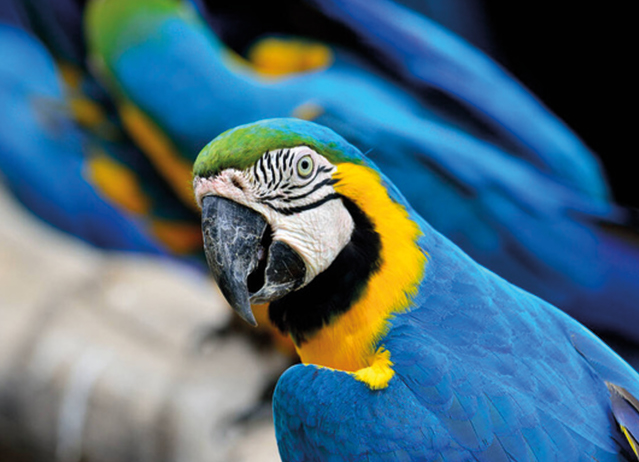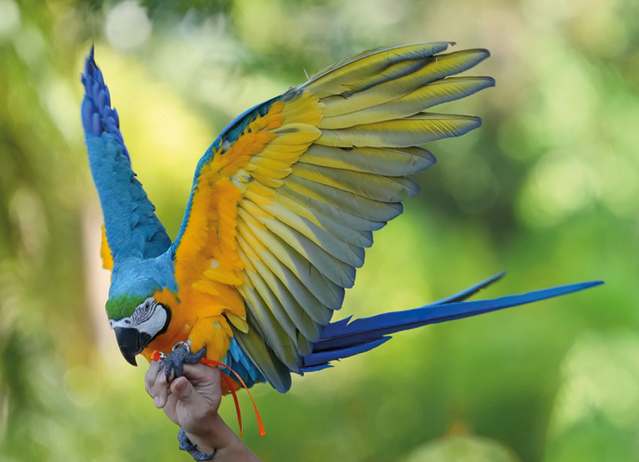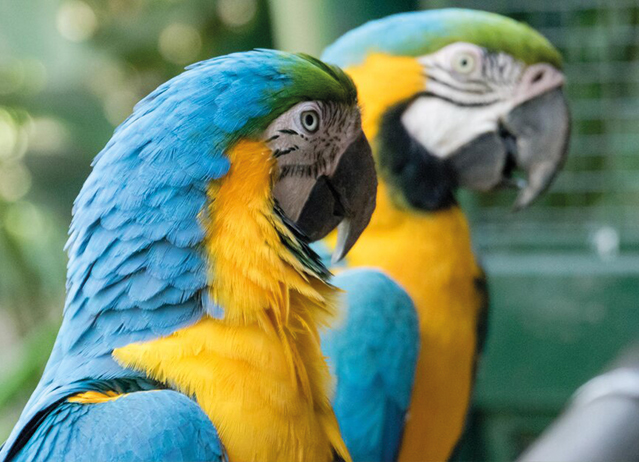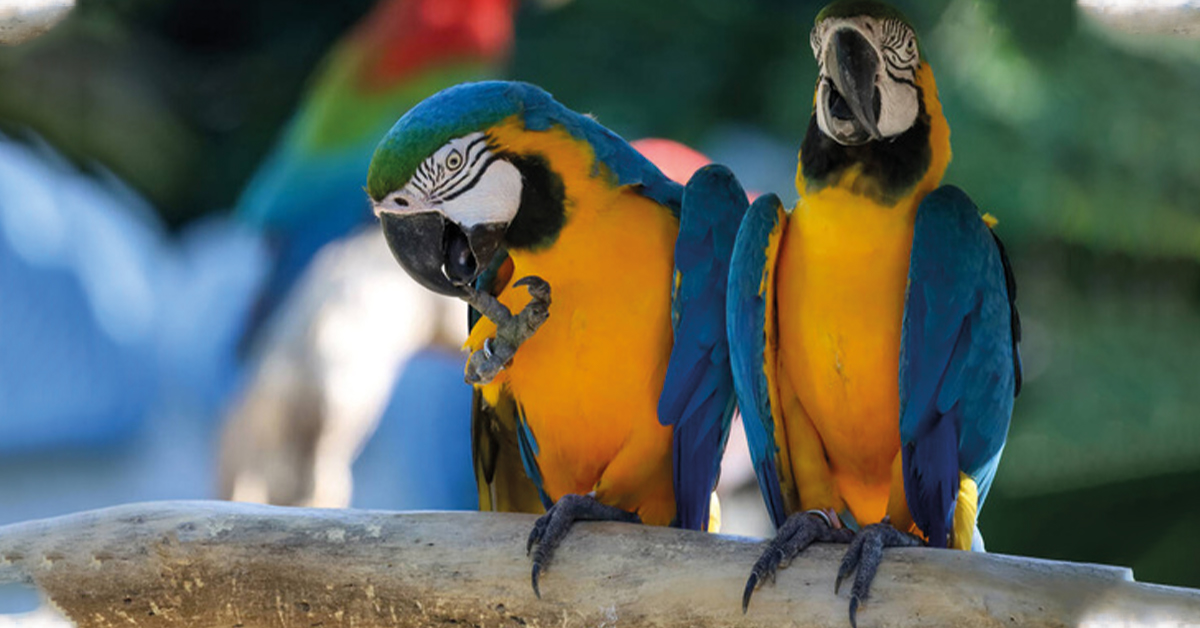Blue and Gold Macaw Information
| Size | 85 to 90 cm (34 to 36 in.) |
| Lifespan | 50 to 60 years |
| Colors | Yellow and Blue |
| Sound | Talking bird, Vocal |
| Bird Species | Parrot |
| Interaction | Affectionate, Intelligent, Highly Social, Playful |
| Comparable Breeds | African Grey Parrot, Scarlet Macaw |
Brilliantly colored, bold, playful, and dignified, Blue and Gold Macaws are one of the most popular large parrots. Colorful as they are, these birds offer more than just visual excitement: they have distinct personalities and a hilariously entertaining presence. Known worldwide as pets, Blue and Gold Macaw pets can be a treasure to handle for someone willing and able to take on a loud and demanding large parrot.
Origin and History
Blue and gold macaws thrive across a vast area in the wild. Their range starts in Panama and covers most countries in northern South America. People have also brought them to Puerto Rico.
These birds prefer to live near rivers and swamps in forests. You can spot them in grassy savannahs too as long as tall trees are around. Blue and gold often travel in pairs. At certain times of the year, they form large flocks. They also meet up in the morning and evening to look for food.
Wild blue and gold macaws face the threat of extinction. Their numbers have dropped because people destroy their homes, hunt them, and catch them. In the past, before breeding programs in captivity began, poachers would steal young birds from nests to sell as pets. This led to many parent macaws dying while trying to protect their babies. many young parrots didn’t make it either. Blue and gold macaws have been bred in the U.S.
since 1935. You can find breeders, and their widespread availability makes these large parrots more budget-friendly than many others.

Native Region/Natural Habitat
Blue-and-Yellow Macaws call home a wide region in northern South America, including Venezuela, Brazil, Paraguay, Peru, and Bolivia. Linnaeus, the well-known Swedish zoologist first spotted and recorded these birds way back in 1758. These colorful parrots like to live near rivers woodlands and rainforests always choosing dead palm trees to build their nests.
While they’re almost gone from Paraguay, you can still find plenty of these eye-catching birds flying around in other parts of their range.
Blue and Gold Macaw Personality
The color and personality of the Blue and Gold Macaw are as vibrant as can be. They are social parrots, and intelligent, and they truly enjoy interacting with their human counterparts. They are quite affectionate, developing close relationships with owners, and they often try to draw attention to themselves for amusement or play. As playful, so curious, and mischievous, this bird will sometimes get into things he shouldn’t. The Blue and Gold Macaws also make great talkers, learning a wide vocabulary and set of phrases, often used appropriately in context to interact with their environment. However, being strong-willed and sometimes stubborn, they must have training and socialization consistently applied to them to prevent behavioral issues. With proper care, attention, and mental stimulation, the Blue and Gold Macaw can be an outstanding and committed companion, and as such, a very entertaining bird that would add flair to any home.
Temperament
The blue and gold macaw seems a great pet due to its social nature and even sweet disposition.
They do very well at adapting to different people and other birds when they are permitted to interact with a variety of people. In terms of being trick birds, the blue and gold macaw are excels. They are always a crowd-pleaser in doing bird shows, and most owners can even take them out and about town with the help of some bird leashes and car seats.
They could be like affectionate dogs moving around the house. These Macaws love to be near their owners and seek attention. They can just sit contently on their perch, watching the activity around them.
Speech and Sound
The blue and gold macaw has the potential for ear-shattering calls that are less than appreciated by your close neighbors. They will not be the best option for those who live in an apartment or condominium setting, or if you have young children who are easily frightened by noise.
This is an excellent talking bird; it learns very fast and makes an effort to please. Training isn’t that much of a problem if you are consistent. The vocabulary of some 20 words and phrases is within their reach. Due to great clarity, most people feel that this parrot is one of the best for talking.

Colors and Markings
The most popular name, blue and gold macaws, is derived from the two most prominent feather colors of these birds. Typically, they have a green forehead that gradually turns to a teal blue that covers the nape, back, tail, and wings, while the chest and the underside of the wings and belly are bright golden yellow.
These birds have big black beaks and a black patch of feathers just underneath its beak. White patches of skin, adorned with rings of tiny black feathers, surround their eyes and are spread out over much of the face.
The blue and gold macaws are monotypic, meaning that there is only one bird that falls into the species. However, experts in birds suggest that there are two variations or subspecies. These are the Bolivian blue and gold macaw, which is a larger bird with more of an actual blue coloring than the typical turquoise, and the blue-throated macaw, a bird with a teal blue throat instead of a black throat.
This bird is a monomorphic species; males and females are barely distinguishable from each other. It had been widely believed that the male has a flatter head, and the female has a narrower beak; the only way to prove the sex of this macaw is through surgical or genetic sexing.
Caring of Blue and Gold Macaw
Like most macaws, the blue and gold macaws thrive on attention from their owners and will form a close bond with their family. Spend time socializing these birds properly and providing them with adequate mental stimulation, or they will resort to screaming out of boredom.
Noisy birds would be contained in a cage at least 5 feet tall and at least 3 or 4 feet wide and long. The bird needs room to stretch its wings and move about by hopping and climbing, as well as space to keep itself entertained.
Some owners even have a dedicated, bird-safe room. Since these birds will peck at almost anything, remove electrical cords, jewelry, and wooden furniture.
The other consideration before you commit to taking this bird home is the cost of ownership. Tacked onto the price of the bird are considerations for quality feed, avian veterinarian bills, and accessory costs associated with a cage, play stand, and toys.
Common Health Problems
These are large, stout, and strong birds, reflecting their size. Their long life, up to 60 years, is also accompanied by rarely ailing pet birds. The main care for them is hygiene, which has to be considered by regular bathing and cleanliness. Some major alarms include apathy, drooping wings, and loss of appetite, which can be caused by social isolation, lack of space, and general neglect.
Large birds are categorized as sturdy and strong pets. Keeping them clean as well as satisfying their social needs is the way to stay healthy.

Blue and Gold Macaw Diet
In the wild, most macaws, including blue-and-gold macaws, eat a lot of seeds, plant material, fruits, and nuts. The diet for captive blue and gold macaws needs to be very varied and include as many types of fresh fruits and vegetables as possible. There needs to be a good pelleted diet with some healthy seeds like flax, hemp, and chia in this mix.
The size of the macaw will determine how much he eats: about ½ to ¾ cup of parrot mix and ½ to ¾ cup of fruit and vegetables. You can feed it once in the morning after waking and at dusk before it goes to sleep. Take out all uneaten food before bed.
Good fruits to offer your macaw include apples, pears, plums, cherries, grapes, oranges, bananas, mangos, papayas, and berries. Good vegetables include carrots, sweet potatoes, cucumbers, zucchini, and leafy greens. Avoid avocados, chocolate, and rhubarb because they are toxic to birds.4 As an occasional training reward, you can use nuts, such as macadamias, walnuts, pecans, almonds, and hazelnuts.
Exercise
The Blue-and-Gold Macaw is an extremely active, energetic bird. They do require time outside the cage to stretch and flap their wings.
You may encourage climbing up and down your stairs, or you can provide them with a rope ladder to exercise on that will strengthen their legs and feet.
Place your Macaw on your arm, gently moving your arm up and down, or around in circles. This will cause your macaw to flap its wings to maintain its balance.
Try playing games with and putting on music to get your Blue-and-Gold dancing. Be sure he has plenty of toys inside his cage, too, to encourage him to exercise inside the cage as well.
You must spend at least 2 to 3 hours with your Macaw outside his cage to help him stretch his wings and, more importantly, socialize.
Related: Blue Headed Racket Tail Parrot

